“Continuous” Backstepping of Holocene Coastal Barrier Systems into Incised Valleys: Insights from the Ofanto and Carapelle-Cervaro Valleys
Abstract
:1. Introduction
2. Regional Setting
3. Methods
3.1. Seismic Survey
3.2. Seismic Facies and Unconformity-Bounded Seismic Units
3.3. Age Range Evaluation and Chronological Constraints
4. Data and Results
4.1. Erosional Surface ES1
4.2. Erosive Landform: Incised Valley A and B
4.3. Borehole and Vibrocores
4.3.1. Borehole ZS2
- from 30 to 29 m below ground level (−28.8 to −27.8 m b.s.l.), light grey clay with Cyprideis torosa, Pulmonata, Characeae and vegetal remnants;
- from 29 to 28.5 m (−27.8 to −27.3 m b.s.l.), dark grey clay rich in Cerastoderma glaucum (Bruguiere), Abra segmentum (Recluz), Turboella lineolata (Michaud), and Hydrobiidae spp.;
- from 28.5 to 27.8 m (−27.3 to −26.6 m b.s.l.), graded light grey pumice, from very coarse to medium-fine;
- from 27.8 to 24.5 m (−26.6 to −23.3 m b.s.l.), very dark and dark grey clay rich in C. glaucum and Bittium reticulatum (Da Costa) in the lowest 30 cm. In the remaining part of the unit, the fauna is different: first, the fauna is composed of species such as Ostea edulis (Linneo), Modiolus barbatus (Linneo) and Mysella bidentata (Montagu); then, the fauna comprises M. bidentata, Nucula nitidosa (Winckworth), Abra nitida (Müller), and Dentalium inaequicostatum (Dautz);
- 5.
- from 30 to 29 m below ground level (−28.8 to −27.8 m b.s.l.), light grey clay with Cyprideis torosa, Pulmonata, Characeae and vegetal remnants;
- 6.
- from 29 to 28.5 m (−27.8 to −27.3 m b.s.l.), dark grey clay rich in Cerastoderma glaucum (Bruguiere), Abra segmentum (Recluz), Turboella lineolata (Michaud), and Hydrobiidae spp.;
- 7.
- from 28.5 to 27.8 m (−27.3 to −26.6 m b.s.l.), graded light grey pumice, from very coarse to medium-fine;
- 8.
- from 27.8 to 24.5 m (−26.6 to −23.3 m b.s.l.), very dark and dark grey clay rich in C. glaucum and Bittium reticulatum (Da Costa) in the lowest 30 cm. In the remaining part of the unit, the fauna is different: first, the fauna is composed of species such as Ostea edulis Linneo, Modiolus barbatus Linneo and Mysella bidentata (Montagu); then, the fauna comprises M. bidentata, Nucula nitidosa (Winckworth), Abra nitida (Müller), and Dentalium inaequicostatum (Dautz).
- 9.
- from 24.0 to 14.0 m (−22.8 to −12.8 m b.s.l.), grey, dark grey, or leaden clay, generally with abundant and diversified fauna: Tellina distorta (Poli), Corbula gibba (Olivi), M. bidentata, Pitar rudis (Poli), Gouldia minima (Montagu), A. nitida, Nuculana pella (Linneo), N. nitidosa, and D. inaequicostatum. Many ossicles of Asteroidea and vertebrae of Ophiuroidea are present;
- 10.
- from 14.0 to 12.45 m (−12.8 to −11.25 m. b.s.l.), dark grey clay layers alternating with a thin layer of light grey silt containing rare specimens of A. nitida, C. gibba, N. pella, N.a nitida, and Odostomia sp.;
- 11.
- from 12.45 to 8.0 m (−11.25 to −6.8 m b.s.l.), dark grey to light grey fine silty sand, containing rare specimens of A. nitida and N. pella;
- 12.
- from 8.0 to 1.75 (−6.8 to −0.55 m b.s.l.), grey brown to dark grey medium-coarse sand; two thin layers of gravels in a sandy matrix with abundant shell fragments (Glycymeris sp., Chamelea gallina (Linneo), Donax sp.) are present at approximately −6.5 and −3.5 m, respectively; and
- 13.
- from 1.75 to 0.0 m (−0.55 to +1.2 m b.s.l.), vegetal soil and anthropic backfill.
4.3.2. Vibro-cores SP1_VC24 and SP1_VC25
- from 5.13 to 3.59 m, bioclastic coarse material with some pelitic intercalation;
- from 3.59 to 3.27 m, coarse black sand with abundant bioclasts and pebbles;
- from 3.27 to 2.43 m, fine and very fine light olive brown sand. Pockets of coarse bioclastic black sand are present;
- from 2.43 to 0.79 m, bioclastic gravel and coarse sand in a grey pelitic matrix, with abundant vegetal remnants towards the lower part of the level; and
- from 0.79 m to the sea floor, bioclastic gravel of bivalves and gastropods in a clayey-sandy, dark grey matrix.
- from 5.20 to 2.92 m, very fine ochre pelitic sand, with many clay intercalations of various greyish shades;
- from 2.92 to 2.61 m, bioclastic gravel in an ochre sandy/pelitic matrix;
- from 2.61 to 1.52 m, very fine ochre sand with rare small bioclasts;
- from 1.52 to 0.78 m, bioclastic gravel in an ochre sandy/pelitic matrix; and
- from 0.78 m to the sea floor, fine and very fine ochre sand.
4.4. Seismic Facies
- Facies 1 (Figure 8A,B). This facies is only present at the bottom of the incised valleys and is characterised by high amplitude down-lapping reflector or sets of concave and/or convex and/or wavy reflectors; reflectors also show frequent changes in dip direction; the lateral continuity is low-medium. In the seismic profiles normal to the narrow valley axes, the reflectors present a conformable channel infill pattern.
- Facies 2. These seismic facies can be divided into two subtypes: 2a and 2b. Facies 2a (Figure 8C): this facies, in general, has a chaotic, non-symmetrical internal configuration with reflectors of low or very low amplitude and very low lateral continuity. Commonly, these facies contains V and Λ-shaped reflectors. Alternatively, the reflectors are undulating, concave, convex or oblique-parallel, but always with low amplitude and very low lateral continuity. Facies 2b (Figure 8D): the reflectors are sigmoidal and/or clinoform with moderate-high amplitude and medium-high lateral continuity, which alternate with low amplitude reflectors or with chaotic and non-symmetrical packages, and all are inclined landward. Facies 2 overlies ES1 on the shelf and previous infilling units in IV1 and IV2. From offshore to onshore, a transition between facies 2 and facies 3 or 4 is often observed.
- Facies 3 (Figure 8E,F). This facies is characterised by moderate amplitude and plane-parallel reflectors with medium lateral continuity; sometimes, reflectors are weakly undulating with low lateral continuity. This facies overlies ES1 or seismic facies 1. The relationship with seismic facies 2 is twofold: in some cases, facies 2 transitions landwards into facies 3; in other cases, facies 3 is surmounted by facies 2.
- Facies 4 (Figure 8G,H). This facies is characterised by moderate to high amplitude, medium-high lateral continuity plane-parallel reflectors alternating with wavy or gently inclined reflectors. The relationship of facies 4 with seismic facies 2 is twofold: in some cases, facies 2 transitions landwards into facies 4; in other cases, facies 5 is surmounted by facies 2.
- Facies 5 (Figure 8I). This facies is characterised by moderate amplitude and medium lateral continuity reflectors, with the presence of a topset, fore-set and bottomset; thus, it is a pro-gradational seismic facies. Downdip, this facies transitions into facies 3.
4.5. Unconformity-Bounded Seismic Units
4.5.1. Unit Au
4.5.2. Unit Bu
4.5.3. Unit Cu
4.5.4. Unit Du
4.5.5. Unit Eu
4.5.6. Unit Fu
4.5.7. Unit Gu
5. Discussion
5.1. Erosional Surface ES1
5.2. Borehole ZS2 and Vibrocores SP1_VC24 and SP1_VC52
5.3. Interpretation of Seismic Facies
5.4. Interpretation of UBSUs and Transgressive Architecture (Sea Level Ranges and Deposition of UBSUs)
5.4.1. Sea-Level Range 1: up to ca. −39 m b.s.l.
5.4.2. Sea-Level Range 2: from ca. −39 to ca. −29 m b.s.l.
5.4.3. Sea-Level Range 3: from ca. −29 to ca. −18 m b.s.l.
5.4.4. Sea-Level Range 4: from ca. −18 to ca. −4.7 m b.s.l
5.5. Focus on Beach/Spit-Backbarrier Systems in CCV and OSFV Infilling
5.5.1. CCV Infilling
5.5.2. OSFV Infilling
5.6. Palaeoenvironmental and Palaeoclimatic Considerations
6. Conclusions
Author Contributions
Funding
Acknowledgments
Conflicts of Interest
References
- Otvos, E.G. Coastal barriers-nomenclature, processes, and classification issues. Geomorphology 2012, 139–140, 39–52. [Google Scholar] [CrossRef]
- Stutz, M.I.; Pilkey, O.H. Open-ocean barrier islands. Global influence of climatic, oceanographic, and depositional settings. J. Coast. Res. 2011, 27, 207–222. [Google Scholar] [CrossRef]
- Otvos, E.G. Coastal barriers, northern Gulf - Last Eustatic Cycle; genetic categories and development contrasts. A review. Quat. Sci. Rev. 2018, 193, 212–243. [Google Scholar] [CrossRef]
- Hesp, P.A.; Short, A.D. Barrier morphodynamics. In Handbook of Beach and Shoreface Morphodynamics; Short, A.D., Ed.; John Wiley & Sons: Hoboken, NJ, USA, 1999; pp. 307–333. ISBN 978-0-471-96570-1. [Google Scholar]
- De Santis, V.; Caldara, M.; Torres, T.; Ortiz, J.E.; Sánchez-Palencia, Y. A review of MIS 7 and MIS 5 terrace deposits along the Gulf of Taranto based on new stratigraphic and chronological data. Ital. J. Geosci. 2018, 137, 349–368. [Google Scholar] [CrossRef]
- De Santis, V.; Caldara, M.; Torres, T.; Ortiz, J.E.; Sánchez-Palencia, Y. The role of beach ridges, spits, or barriers in understanding marine terraces processes on loose or semiconsolidated substrates: Insights from the givoni of the Gulf of Taranto (southern Italy). Geol. J. 2020, 55, 2951–2975. [Google Scholar] [CrossRef]
- Roy, P.S.; Cowell, P.J.; Ferland, M.A.; Thom, B.G. Wave dominated coast. In Coastal Evolution, Late Quaternary Shoreline Morphodynamics; Carter, R.W.G., Woodroffe, C.D., Eds.; Cambridge University Press: Cambridge, UK, 1994; pp. 121–186. ISBN 0-521-59890-7. [Google Scholar]
- Zecchin, M.; Catuneanu, O.; Caffau, M. Wave-ravinement surfaces: Classification and key characteristics. Earth-Sci. Rev. 2019, 188, 210–239. [Google Scholar] [CrossRef]
- Mellett, C.L.; Plater, A.J. Drowned Barriers as Archives of Coastal-Response to Sea-Level Rise. In Barrier Dynamics and Response to Changing Climate; Moore, L.J., Murray, A.B., Eds.; Spinger: Berlin/Heidelberg, Germany, 2018; pp. 57–89. ISBN 978-3-319-68086-6. [Google Scholar]
- Swift, D.J.P.; Moslow, T.F. Holocene transgression in south-central Long Island, New York-discussion. J. Sediment. Petrol. 1982, 53, 1014–1019. [Google Scholar]
- Leatherman, S.P.; Rampino, M.R.; Sanders, J.E. Barrier island evolution in response to sea level rise; discussion and reply. J. Sediment. Res. 1983, 53, 1026–1033. [Google Scholar] [CrossRef]
- De Falco, G.; Antonioli, F.; Fontolan, G.; Lo Presti, V.; Simeone, S.; Tonielli, R. Early cementation and accommodation space dictate the evolution of an overstepping barrier system during the Holocene. Mar. Geol. 2015, 369, 52–66. [Google Scholar] [CrossRef]
- Storms, J.E.A.; Weltje, G.J.; Terra, G.J.; Cattaneo, A.; Trincardi, F. Coastal dynamics under conditions of rapid sea-level rise: Late Pleistocene to Early Holocene evolution of barrier-lagoon systems on the northern Adriatic shelf (Italy). Quat. Sci. Rev. 2008, 27, 1107–1123. [Google Scholar] [CrossRef] [Green Version]
- Mellett, C.L.; Hodgson, D.M.; Mauz, B.; Lang, A.; Selby, I.; Plater, A.J. Preservation of a drowned gravel barrier complex: A landscape evolution study from the northeastern English Channel. Mar. Geol. 2012, 315–318, 115–131. [Google Scholar] [CrossRef]
- Cooper, J.A.G.; Green, A.N.; Meireles, R.P.; Klein, A.H.F.; Souza, J.; Toldo, E.E. Sandy barrier overstepping and preservation linked to rapid sea level rise and geological setting. Mar. Geol. 2016, 382, 80–91. [Google Scholar] [CrossRef]
- Green, A.N.; Cooper, J.A.G.; Salzmann, L. Geomorphic and stratigraphic signals of postglacial meltwater pulses on continental shelves. Geology 2014, 24, 151–154. [Google Scholar] [CrossRef]
- Green, A.N.; Cooper, J.A.G.; Leuci, R.; Thackeray, R. Formation and preservation of an overstepped segmented lagoon complex on a high-energy continental shelf. Sedimentology 2013, 60, 1755–1768. [Google Scholar] [CrossRef]
- Belknap, D.F.; Kraft, J.C. Preservation potential of transgressive coastal lithosomes on the U.S. Atlantic Shelf. Mar. Geol. 1981, 41, 419–442. [Google Scholar]
- Belknap, D.F.; Kraft, J.C. Influence of antecedent geology on evolution of barrier systems. Mar. Geol. 1985, 63, 235–262. [Google Scholar] [CrossRef]
- Belknap, D.F.; Kraft, J.C.; Dunn, R.K. Transgressive valley-fill lithosomes: Delaware and Maine. In Incised-Valley Systems: Origin and Sedimentary Sequences; Dalrymple, R., Boyd, R., Zaitlin, B., Eds.; SEPM: Broken Arrow, OK, USA, 1994; Volume 51, pp. 303–320. [Google Scholar]
- Storms, J.E.A.; Swift, D.J.P. Shallow marine sequences as the building blocks of stratigraphy: Insights from numerical modelling. Basin Res. 2003, 15, 287–303. [Google Scholar] [CrossRef]
- De Santis, V.; Caldara, M.; Torres, T.; Ortiz, J.E. Stratigraphic units of the Apulian Tavoliere Plain: Chronology, correlation with marine isotope stages and implication regarding vertical movements. Sediment. Geol. 2010, 228, 255–270. [Google Scholar] [CrossRef] [Green Version]
- De Santis, V.; Caldara, M.; Pennetta, L.; Torres, T.; Ortiz, J.E. Unconformity bounded stratigraphic units in an Italian alluvial plain area: Recognising and dating. J. Sediment. Res. 2013, 83, 96–114. [Google Scholar] [CrossRef]
- De Santis, V.; Caldara, M.; Torres, T.; Ortiz, J.E. Two middle Pleistocene warm stages in the terraced deposits of the Apulia region (southern Italy). Quat. Int. 2014, 332, 2–18. [Google Scholar] [CrossRef]
- De Santis, V.; Caldara, M.; Pennetta, L. The marine and alluvial terraces of Tavoliere di Puglia plain (southern Italy). J. Maps 2014, 10, 114–125. [Google Scholar] [CrossRef]
- Caldara, M.; Pennetta, L. Pleistocenic buried abrasion platforms in Southeastern “Tavoliere“ (Apulia, South Italy). Alp. Mediterr. Quat. 1991, 4, 303–309. [Google Scholar]
- Fabbri, A.; Gallignani, P. Ricerche geomorfologiche e sedimentologiche nell’Adriatico meridionale. Giorn Geol. 1972, 38, 453–498. [Google Scholar]
- Trincardi, F.; Argnani, A.; Correggiari, A. Note Illustrative della Carta Geologica dei Mari Italiani, alla scala 1:250,00, Foglio NK33-6 Vieste, e Foglio NK33-8/9 Bari; ISPRA: Roma, Italy, 2011; pp. 1–194. [Google Scholar]
- Trincardi, F.; Correggiari, A.; Ridente, D.; Verdicchio, G.; Cattaneo, A.; Minisini, D.; Remia, A.; Taviani, M.; Asioli, A.; Piva, A.; et al. Carta Geologica dei Mari Italiani, Foglio NK33-8/9 Bari; ISPRA: Roma, Italy, 2011. [Google Scholar]
- Maselli, V.; Trincardi, F. Large-scale single incised valley from a small catchment basin on the western Adriatic margin (central Mediterranean Sea). Glob. Planet Chang. 2013, 100, 245–262. [Google Scholar] [CrossRef]
- Maselli, V.; Trincardi, T.; Asioli, A.; Ceregato, A.; Rizzetto, F.; Taviani, M. Delta growth and river valleys: The influence of climate and sea level changes on the South Adriatic shelf (Mediterranean Sea). Quat. Sci. Rev. 2014, 99, 146–163. [Google Scholar] [CrossRef]
- De Santis, V.; Caldara, M. Evolution of an incised valley system in the southern Adriatic Sea (Apulian margin): An onshore-offshore correlation. Geol. J. 2016, 51, 263–284. [Google Scholar] [CrossRef]
- Cattaneo, A.; Correggiari, A.; Langone, L.; Trincardi, F. The late-Holocene Gargano subaqueous delta, Adriatic shelf: Sediment pathways and supply fluctuations. Mar. Geol. 2003, 193, 61–91. [Google Scholar] [CrossRef]
- Trincardi, F.; Asioli, A.; Cattaneo, A.; Correggiari, A.; Langone, L. Stratigraphy of the late-Quaternary deposits in the Central Adriatic basin and the record of short-term climatic events. Memorie-Istituto Italiano di Idrobiologia 1996, 55, 39–70. [Google Scholar]
- Correggiari, A.; Trincardi, F.; Langone, L.; Roveri, M. Styles of failure in heavily-sedimented highstand prodelta wedges on the Adriatic shelf. J. Sediment. Res. 2001, 71, 218–236. [Google Scholar] [CrossRef]
- Maselli, V.; Hutton, E.W.; Kettner, A.J.; Syvitski, J.P.M.; Trincardi, F. High-frequency sea level and sediment supply fluctuations during Termination I: An integrated sequence-stratigraphy and modeling approach from the Adriatic Sea (Central Mediterranean). Mar. Geol. 2011, 287, 54–70. [Google Scholar] [CrossRef]
- Cattaneo, A.; Trincardi, F. The late-Quaternary transgressive record in the Adriatic epicontinental sea: Basin widening and facies partitioning. In Isolated Shallow Marine Sand Bodies: Sequence Stratigraphic Analysis and Sedimentologic Interpretation; Bergman, K., Snedden, J., Eds.; SEPM: Broken Arrow OK, USA, 1999; Volume 64, pp. 127–146. [Google Scholar]
- Caldara, M.; Capolongo, D.; Del Gaudio, V.; De Santis, V.; Pennetta, L.; Maiorano, P.; Simone, O. Note Illustrative Della Carta Geologica d’Italia alla Scala 1:50.000 Foglio, 409 “Zapponeta”; Istituto Superiore per la Protezione e la ricerca Ambientale: Roma, Italy, in press.
- Mitchum, R.M.; Vail, P.R.; Sangree, J.B. Seismic stratigraphy and global changes in sea-level, part 6. Stratigraphic interpretation of seismic reflection patterns in depositional sequences. In Seismic Stratigraphy-Applications to Hydrocarbon Exploration; Payton, C.E., Ed.; AAPG Memoires: Boulder, Tulsa, OK, USA, 1977; Volume 26, pp. 117–133. ISBN 117-133. [Google Scholar]
- Esker, D.; Eberli, G.P.; McNeill, D.F. The Structural and Sedimentological Controls on the Reoccupation of Quaternary Incised Valleys, Belize Southern Lagoon. AAPG Bull. 1998, 82, 2075–2109. [Google Scholar]
- Maio, C.V.; Gontz, A.M.; Sullivan, R.M.; Madsen, S.M.; Weidman, C.R.; Donnelly, J.P. Subsurface evidence of storm-driven breaching along a transgressing barrier system, Cape Cod, U.S.A. J. Coast. Res. 2015, 32, 264–279. [Google Scholar] [CrossRef] [Green Version]
- Nordfjord, S.; Goff, J.A.; Austin, J.A.; Gulick, S.P.S. Seismic facies of incised-valley fills, New Jersey continental shelf: Implications for erosion and preservation processes acting during latest Pleistocene-Holocene transgression. J. Sediment. Res. 2006, 76, 1284–1303. [Google Scholar] [CrossRef]
- Labaune, C.; Tesson, M.; Gensous, B.; Parize, O.; Imbert, P.; Delhaye-Prat, V. Detailed architecture of a compound incised valley system and correlation with forced regressive wedges: Example of Late Quaternary Têt and Agly rivers, western Gulf of Lions, Mediterranean Sea, France. Sediment. Geol. 2010, 223, 360–379. [Google Scholar] [CrossRef]
- Raynal, O.; Bouchette, F.; Certain, R.; Sabatier, P.; Lofi, J.; Séranne, M.; Dezileau, L.; Briqueu, L.; Ferrer, P.; Courp, T. Holocene evolution of a Languedocian lagoonal environment controlled by inherited coastal morphology (northern Gulf of Lions, France). Bull. Soc. Geol. France 2010, 181, 211–224. [Google Scholar] [CrossRef]
- Pellegrini, C.; Maselli, V.; Cattaneo, A.; Piva, A.; Ceregato, A.; Trincardi, F. Anatomy of a compound delta from the post-glacial transgressive record in the Adriatic Sea. Mar. Geol. 2015, 362, 43–59. [Google Scholar] [CrossRef] [Green Version]
- Catuneanu, O.; Galloway, W.E.; Kendall, C.G.S.t.C.; Miall, A.D.; Posamentier, H.W.; Strasser, A.; Tucker, M.E. Sequence stratigraphy: Methodology and Nomenclature. Newsl. Stratigr. 2011, 44/3, 173–245. [Google Scholar] [CrossRef] [Green Version]
- Lambeck, K.; Antonioli, F.; Anzidei, M.; Ferranti, L.; Leoni, G.; Silenzi, S. Sea level change along the Italian coasts during Holocene and prediction for the future. Quat. Int. 2011, 232, 250–257. [Google Scholar] [CrossRef]
- Reimer, P.J.; Bard, E.; Bayliss, A.; Warren Beck, J.; Blackwell, P.G.; Bronk Ramsey, C.; Buck, C.E.; Cheng, H.; Lawrence Edwards, R.; Friedrich, M.; et al. IntCal13 and Marine13 radiocarbon age calibration curves 0-50000 years cal BP. Radiocarbon 2013, 55, 1869–1887. [Google Scholar] [CrossRef] [Green Version]
- Di Rita, F.; Simone, O.; Caldara, M.; Gehrels, W.R.; Magri, D. Holocene environmental changes in the coastal Tavoliere Plain (Apulia, southern Italy): A multiproxy approach. Palaeogeogr. Palaeoclimatol. Palaeoecol. 2011, 310, 139–151. [Google Scholar] [CrossRef]
- Sulpizio, R.; (University of Bari, Bari, Italy). Personal communication, 2019.
- Andronico, D.; Calderoni, G.; Cioni, R.; Sbrana, A.; Sulpizio, R.; Santacroce, R. Geological map of Somma-Vesuvius volcano. Period Miner. 1995, 64, 77–78. [Google Scholar]
- Santacroce, R.; Cioni, R.; Marianelli, P.; Sbrana, A.; Sulpizio, R.; Zanchetta, G.; Donahue, D.J.; Joron, J.L. Age and whole rock—glass compositions of proximal pyroclastics from the major explosive eruptions of Somma-Vesuvius: A review as a tool for distal tephrostratigraphy. J. Volcanol. Geotherm. Res. 2008, 177, 1–18. [Google Scholar] [CrossRef]
- Marzolla, B. Provincia di Capitanata; Real Officio Topografico della Guerra: Napoli, Italy, 1851. [Google Scholar]
- Caldara, M.; Pennetta, L.; Simone, O. Holocene Evolution of the Salpi Lagoon (Puglia, Italy). J. Coast. Res. 2002, 36, 124–133. [Google Scholar] [CrossRef]
- Pérès, J.M. The Mediterranean benthos. Oceanogr. Mar. Biol. 1967, 5, 449–533. [Google Scholar]
- Picard, J. Recherches qualitatives sur les Biocoenoses marines des substrats meubles dragables de la région marseillaise. Recueil Trav. Stat. Mar. Endoume 1965, 36, 1–102. [Google Scholar]
- Gravina, M.F.; Ardizzone, G.D.; Scaletta, F.; Chimenz, C. Descriptive analysis and classification of benthic communities in some Mediterranean coastal lagoons (central Italy). Mar. Ecol. 1989, 10, 141–216. [Google Scholar] [CrossRef]
- Lambeck, K.; Antonioli, F.; Purcell, A.; Silenzi, S. Sea-level change along the Italian coast for the past 10,000 yr. Quat. Sci. Rev. 2004, 23, 1567–1598. [Google Scholar] [CrossRef]
- Primavera, M.; Simone, O.; Fiorentino, G.; Caldara, M. The Palaeo-environmental study of the Alimini Piccolo Lake enables a reconstruction of Holocene sea-level changes in south-east Italy. Holocene 2011, 21, 553–563. [Google Scholar] [CrossRef]
- Vacchi, M.; Marriner, N.; Morhange, C.; Spada, G.; Fontana, A.; Rovere, A. Multiproxy assessment of Holocene relative sea-level changes in the western Mediterranean: Sea-level variability and improvements in the definition of the isostatic signal. Earth-Sci. Rev. 2016, 155, 172–197. [Google Scholar] [CrossRef] [Green Version]
- Billy, J.; Robin, N.; Hein, C.J.; FitzGerald, D.M.; Certain, R. Impact of relative sea-level changes since the last deglaciation on the formation of a composite paraglacial barrier. Mar. Geol. 2018, 400, 76–93. [Google Scholar] [CrossRef]
- Tillmann, T.; Wunderlich, J. Barrier rollover and spit accretion due to the combined action of storm surge induced washover events and progradation: Insights from ground-penetrating radar surveys and sedimentological data. J. Coast. Res. 2013, 65, 600–605. [Google Scholar] [CrossRef]
- Patruno, S.; Hampson, G.J.; Jackson, C.A.-L. Quantitative characterisation of deltaic and subaqueous clinoforms. Earth-Sci. Rev. 2015, 142, 79–119. [Google Scholar] [CrossRef] [Green Version]
- Montes, A.; Bujalesky, G.G.; Paredes, J.M. Geomorphology and internal architecture of Holocene sandy-gravel beach ridge plain and barrier spits at Río Chico area, Tierra del Fuego, Argentina. J. S. Am. Earth Sci. 2018, 84, 172–183. [Google Scholar] [CrossRef]
- Timmons, E.A.; Rodriguez, A.B.; Mattheus, C.R.; DeWitt, R. Transition of a regressive to a transgressive barrier island due to backbarrier erosion, increased storminess, and low sediment supply: Bogue Banks, North Carolina, USA. Mar. Geol. 2010, 278, 100–114. [Google Scholar] [CrossRef]
- Ariztegui, D.; Asioli, A.; Lowe, J.J.; Trincardi, F.; Vigliotti, L.; Tamburini, F.; Chondrogianni, C.; Accorsi, C.A.; Bandini Mazzanti, M.; Mercuri, A.M.; et al. Palaeoclimate and the formation of sapropel S1: Inferences from Late Quaternary lacustrine and marine sequences in the central Mediterranean region. Palaeogeogr. Palaeoclimatol. Palaeoecol. 2000, 158, 215–240. [Google Scholar] [CrossRef]
- Tesi, T.; Asioli, A.; Minisini, D.; Maselli, V.; Dalla Valle, G.; Gamberi, F.; Langone, L.; Cattaneo, A.; Montagna, P.; Trincardi, F. Large-scale response of the Eastern Mediterranean thermohaline circulation to African monsoon intensification during sapropel S1 formation. Quat. Sci. Rev. 2017, 159, 139–154. [Google Scholar] [CrossRef] [Green Version]
- Cronin, T.M.; Vogt, P.R.; Willard, D.A.; Thunell, R.C.; Halka, J.; Berke, M.; Pohlman, J. Rapid sea level rise and ice sheet response to 8200-year climate event. Geophys. Res. Lett. 2007, 34. [Google Scholar] [CrossRef] [Green Version]
- Kendall, R.A.; Mitrovica, J.X.; Milne, G.A.; Törnqvist, T.E.; Li, Y. The sea-level fingerprint of the 8.2 ka climate event. Geology 2008, 36, 423–426. [Google Scholar] [CrossRef]
- Hijma, M.P.; Coen, K.M. Timing and magnitude of the sea-level jump preluding the 8200 yr event. Geology 2010, 38, 275–278. [Google Scholar] [CrossRef]
- Billy, J.; Robin, N.; Hein, C.J.; FitzGerald, D.M.; Certain, R. Dominance of inherited geologic framework on the development of coastal barrier system. J. Coast. Res. 2018, 85, 406–410. [Google Scholar] [CrossRef]
- De Rijk, S.; Hayes, A.; Rohling, E.J. Eastern Mediterranean sapropel S1 interruption: An expression of the onset of history of climatic deterioration around 7 ka B.P. Mar. Geol. 1999, 153, 337–343. [Google Scholar] [CrossRef]
- De Santis, V.; Caldara, M. The 5.5-4.5 kyr climatic transition as recorded by the sedimentation pattern of coastal deposits of Apulia region, southern Italy. Holocene 2015, 25, 1313–1329. [Google Scholar] [CrossRef]
- Liu, J.P.; Milliman, J.D. Reconsidering melt-water pulses 1A and 1B: Global impacts of rapid sea-level rise. J. Ocean U China 2004, 3, 183–190. [Google Scholar] [CrossRef]
- Sanders, J.E.; Kumar, N. Evidence of shoreface retreat and in-place “drowning” during Holocene submergence of barriers, shelf off Fire Island, New York. Geol. Soc. Am. Bull. 1975, 86, 65–76. [Google Scholar] [CrossRef]
- Rampino, M.R.; Sanders, J.E. Holocene transgression in south-central Long Island, New York. J. Sediment. Petrol. 1980, 50, 1063–1080. [Google Scholar]
- Grant, K.M.; Grimm, R.; Mikolajewicz, U.; Marino, G.; Ziegle, M.; Rohling, E.J. The timing of Mediterranean sapropel deposition relative to insolation, sea-level and African monsoon changes. Quat. Sci. Rev. 2016, 140, 125–141. [Google Scholar] [CrossRef] [Green Version]
- Rossignol-Strick, M.; Nesteroff, W.; Olive, P.; Vergnaud-Grazzini, C. After the deluge: Mediterranean stagnation and sapropel formation. Nature 1982, 295, 105–110. [Google Scholar] [CrossRef]
- Rohling, E.J. Review and new aspects concerning the formation of eastern Mediterranean sapropels. Mar. Geol. 1994, 122, 1–28. [Google Scholar] [CrossRef]
- Piccarreta, M.; Caldara, M.; Capolongo, D.; Boenzi, F. Holocene geomorphic activity related to climatic change and human impact in Basilicata, southern Italy. Geomorphology 2011, 128, 137–147. [Google Scholar] [CrossRef]
- Cattaneo, A.; Steel, R.J. Transgressive deposits: A review of their variability. Earth-Sci. Rev. 2003, 62, 187–228. [Google Scholar] [CrossRef]
- Billy, J.; Robin, N.; Hein, C.J.; Certain, R.; FitzGerald, D.M. Insight into the late Holocene sea-level changes in the NW Atlantic from a paraglacial beach-ridge plain south of Newfoundland. Geomorphology 2015, 248, 134–146. [Google Scholar] [CrossRef]
- Bard, E.; Hamelin, B.; Fairbanks, R.G. U-Th ages obtained by mass spectrometry in corals from Barbados: Sea level during the past 130,000 years. Nature 1990, 346, 456–458. [Google Scholar] [CrossRef]
- Bard, E.; Hamelin, B.; Arnold, M.; Montaggioni, L.; Cabioch, G.; Faure, G.; Rougerie, F. Deglacial sea-level record from Tahiti corals and the timing of global Meltwater discharge. Nature 1996, 382, 241–244. [Google Scholar] [CrossRef]

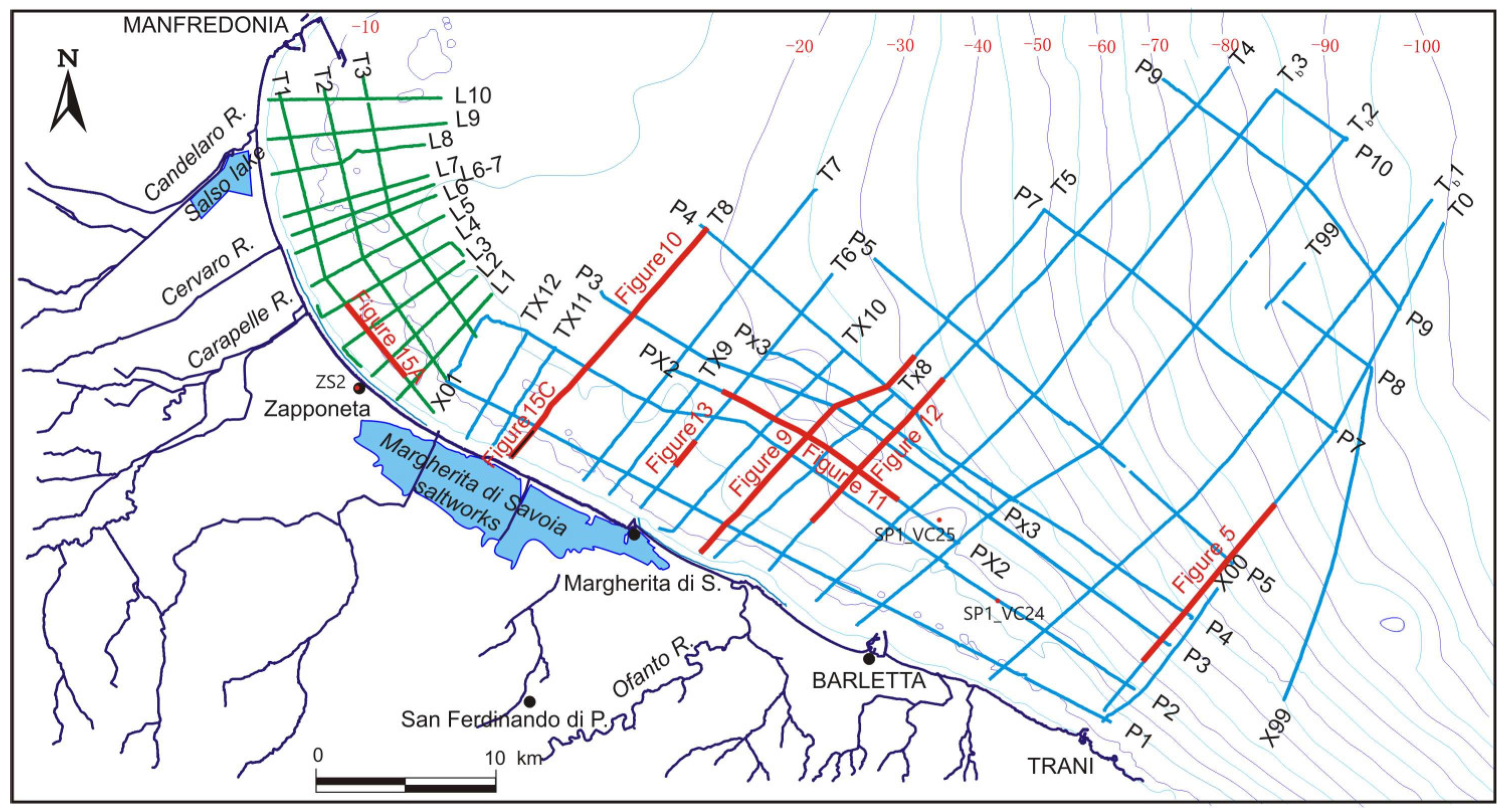
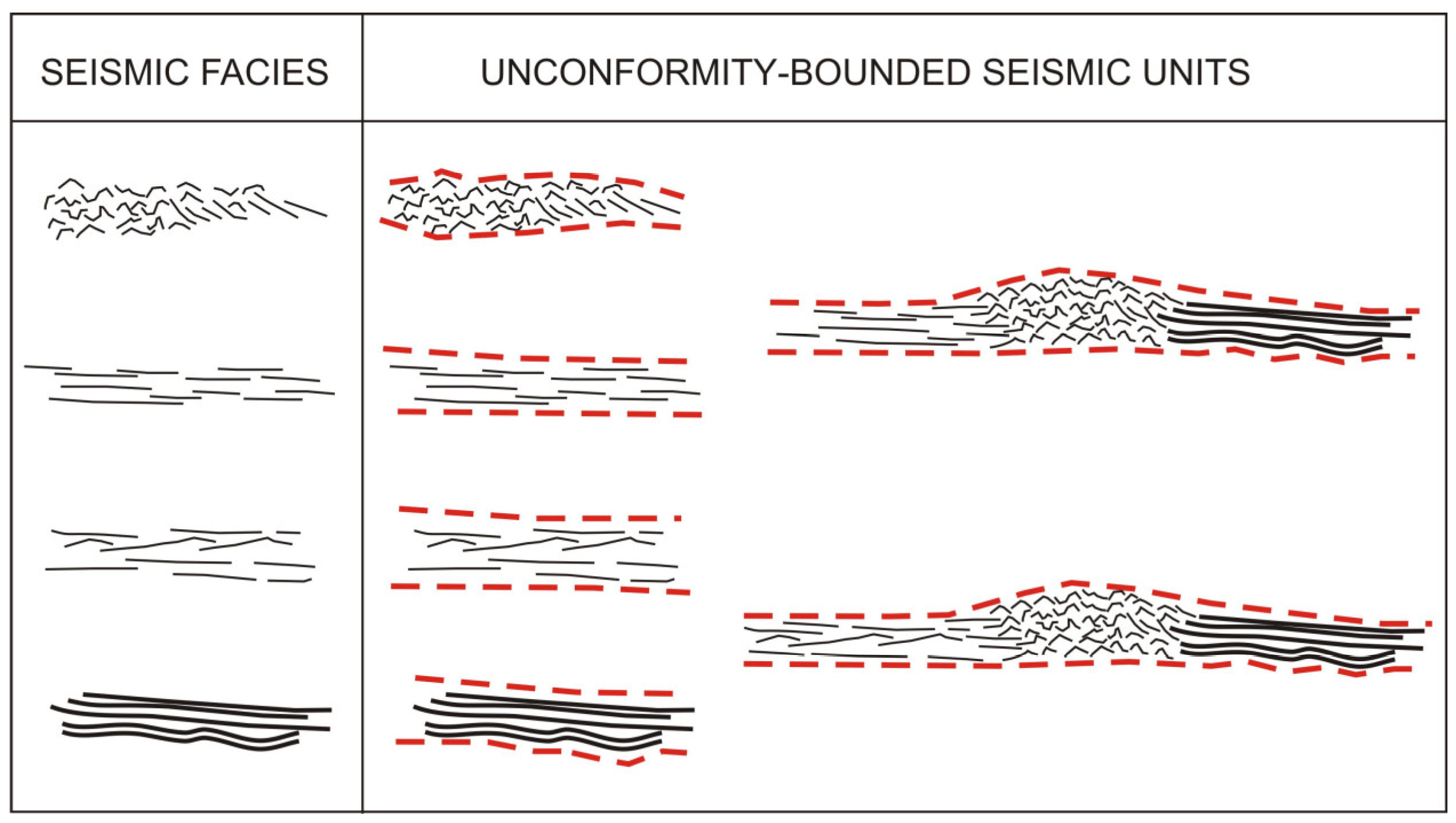
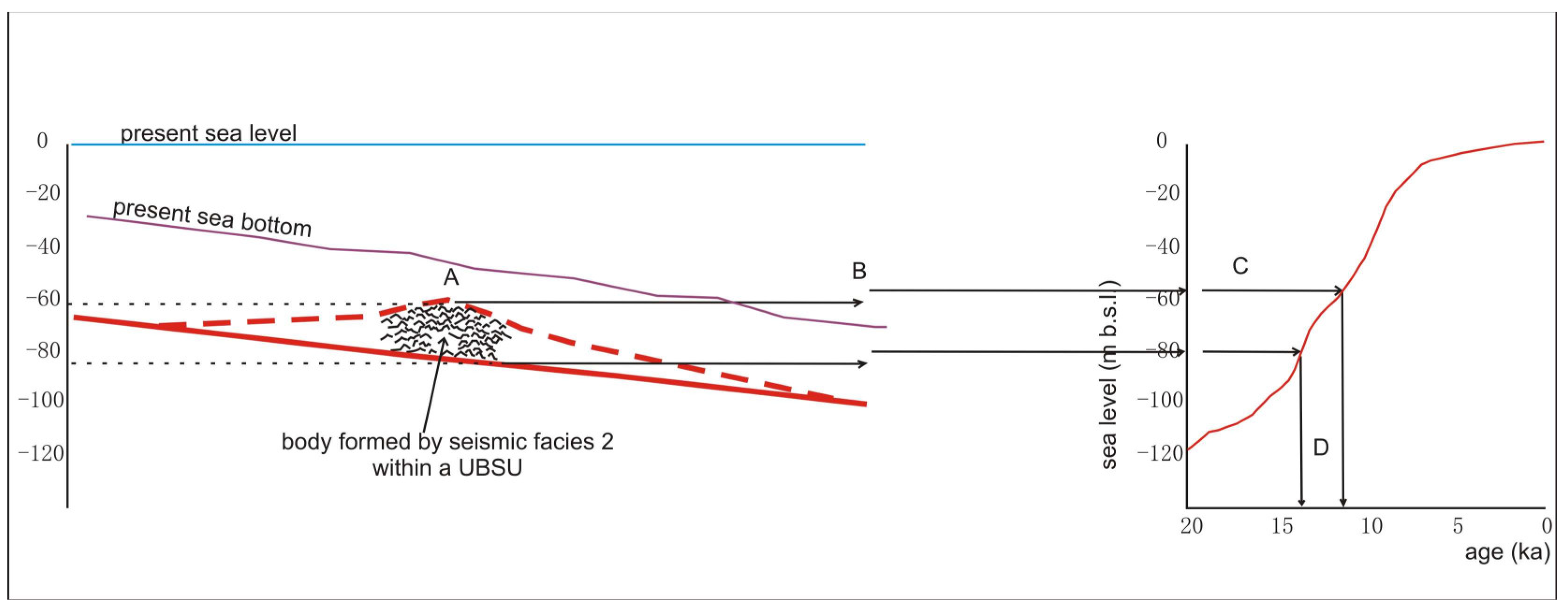
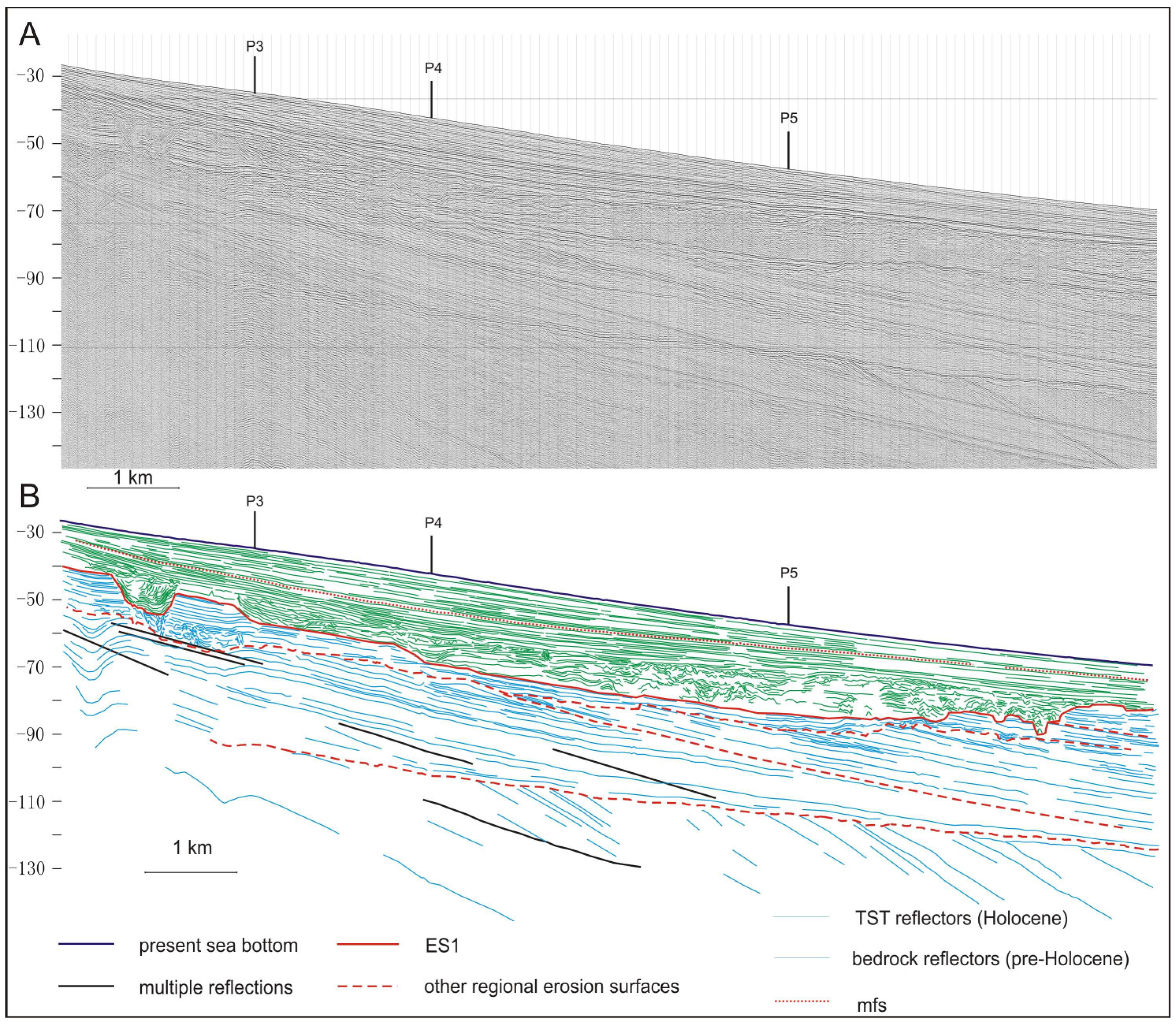
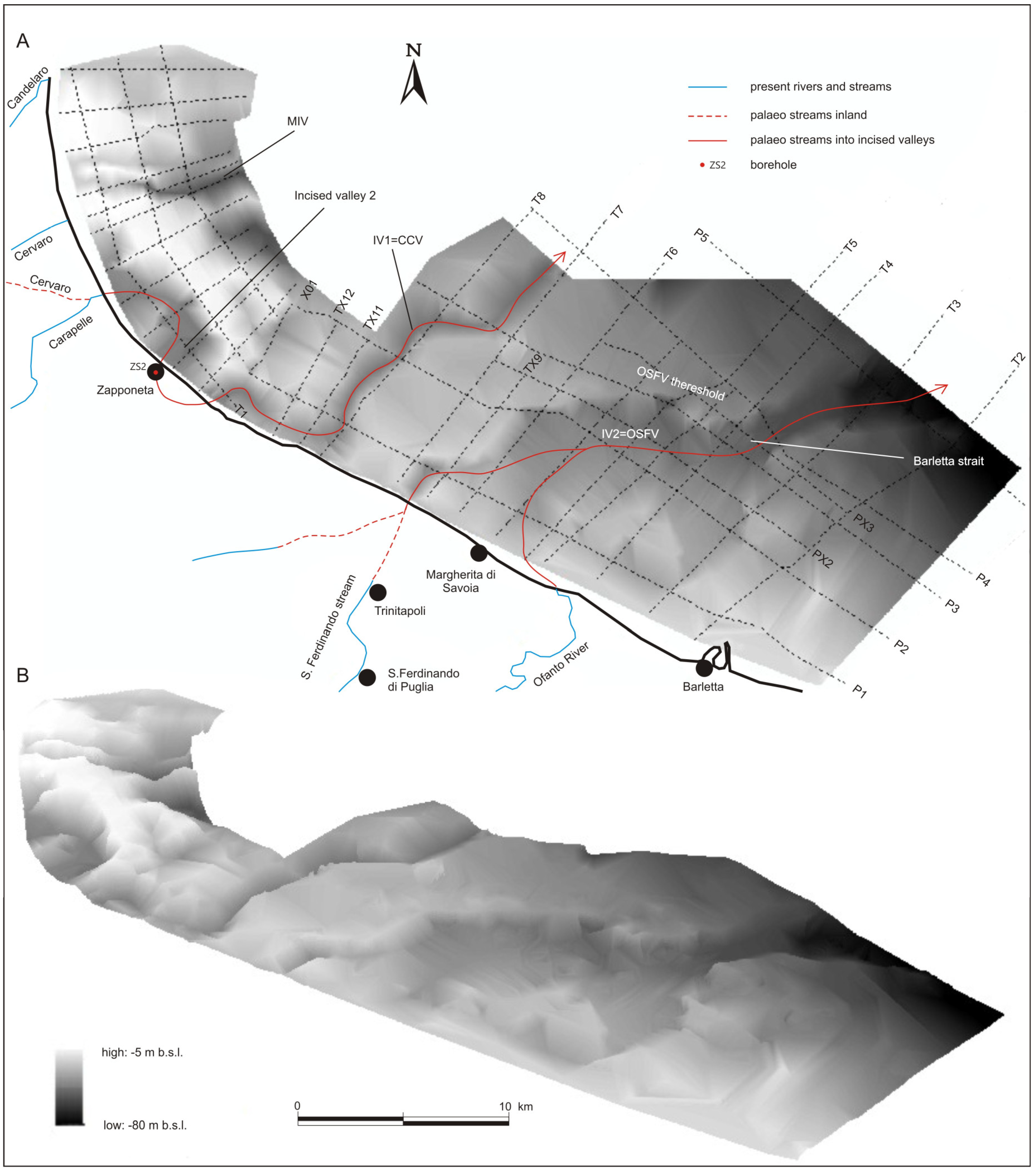
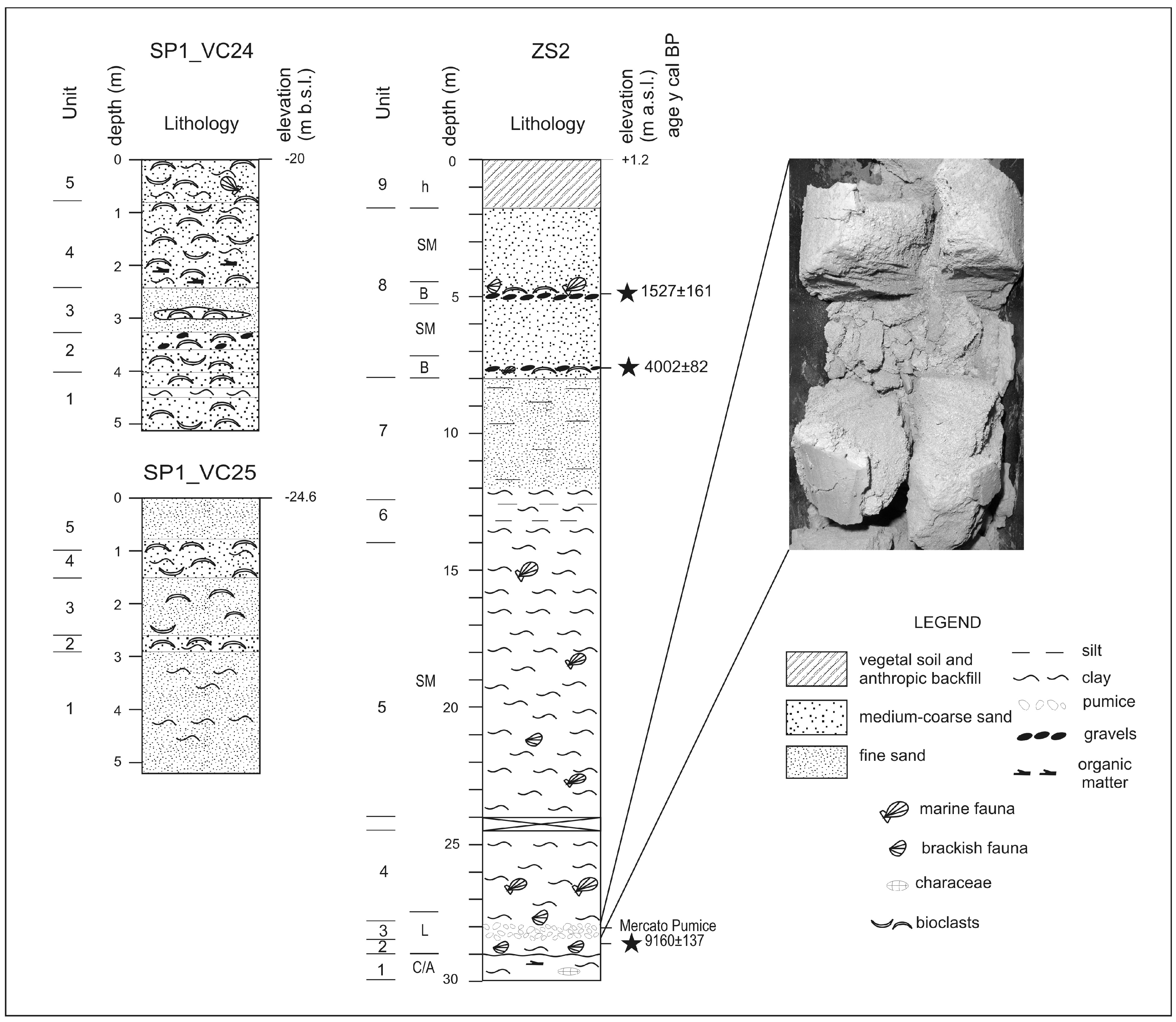
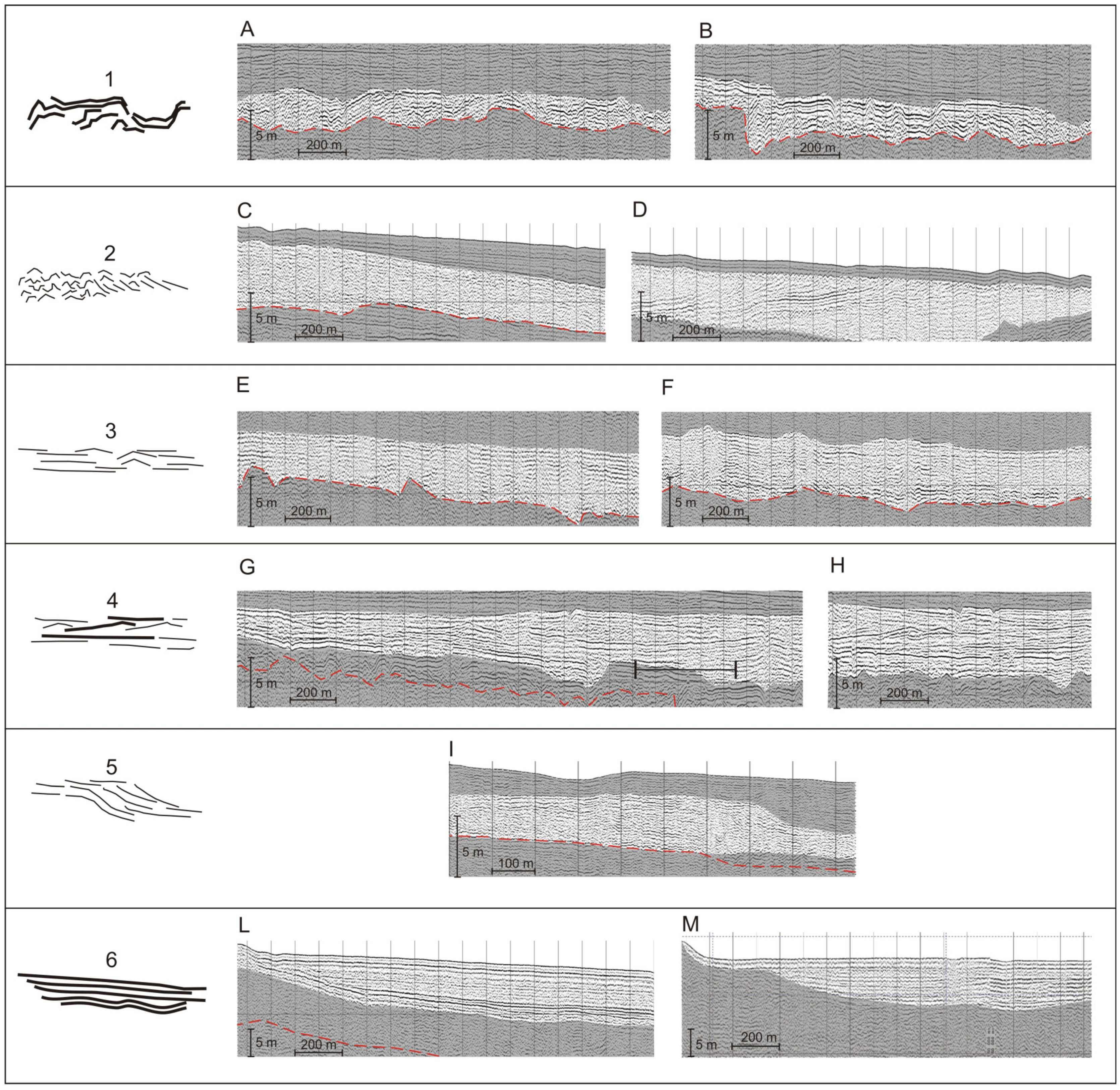
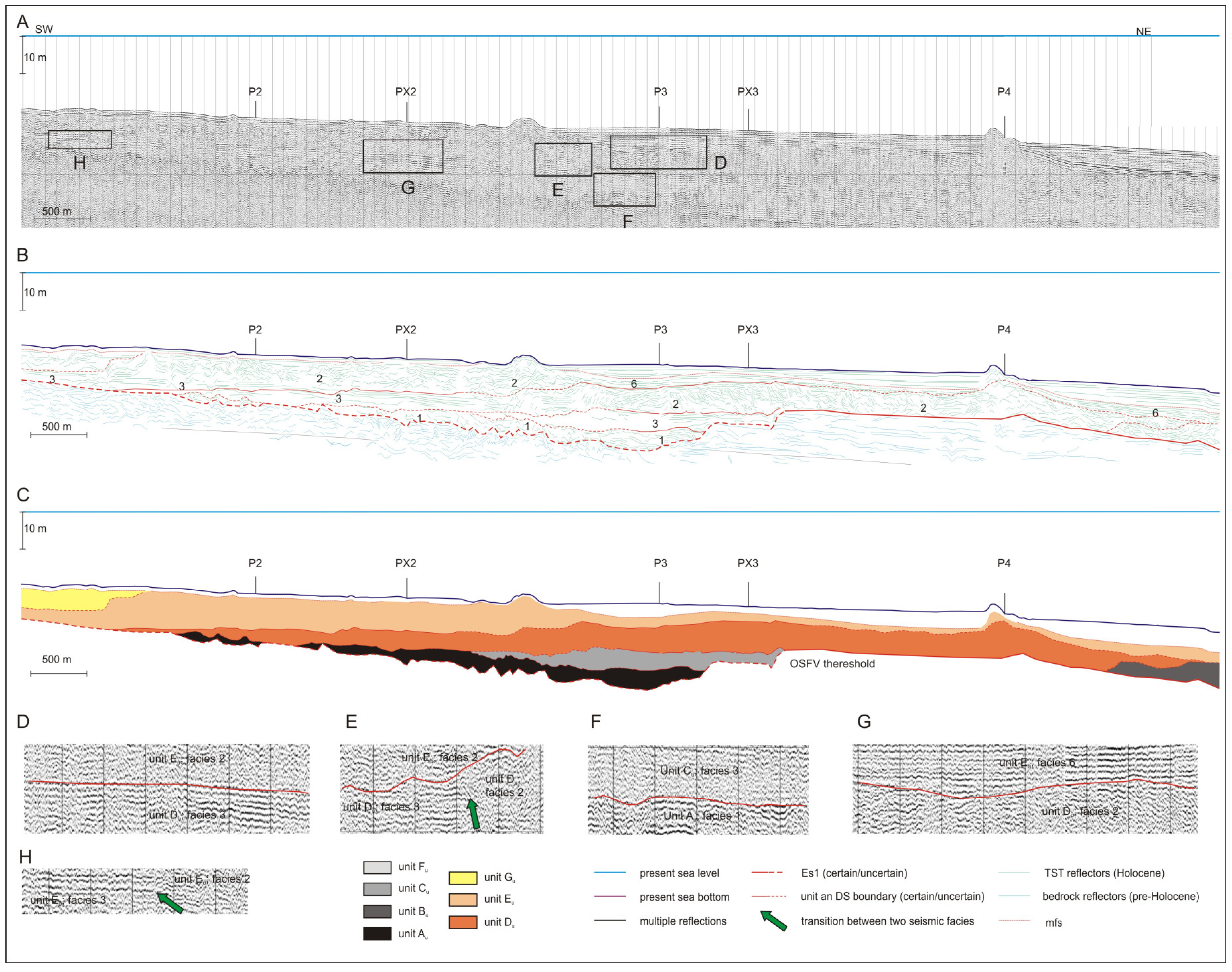
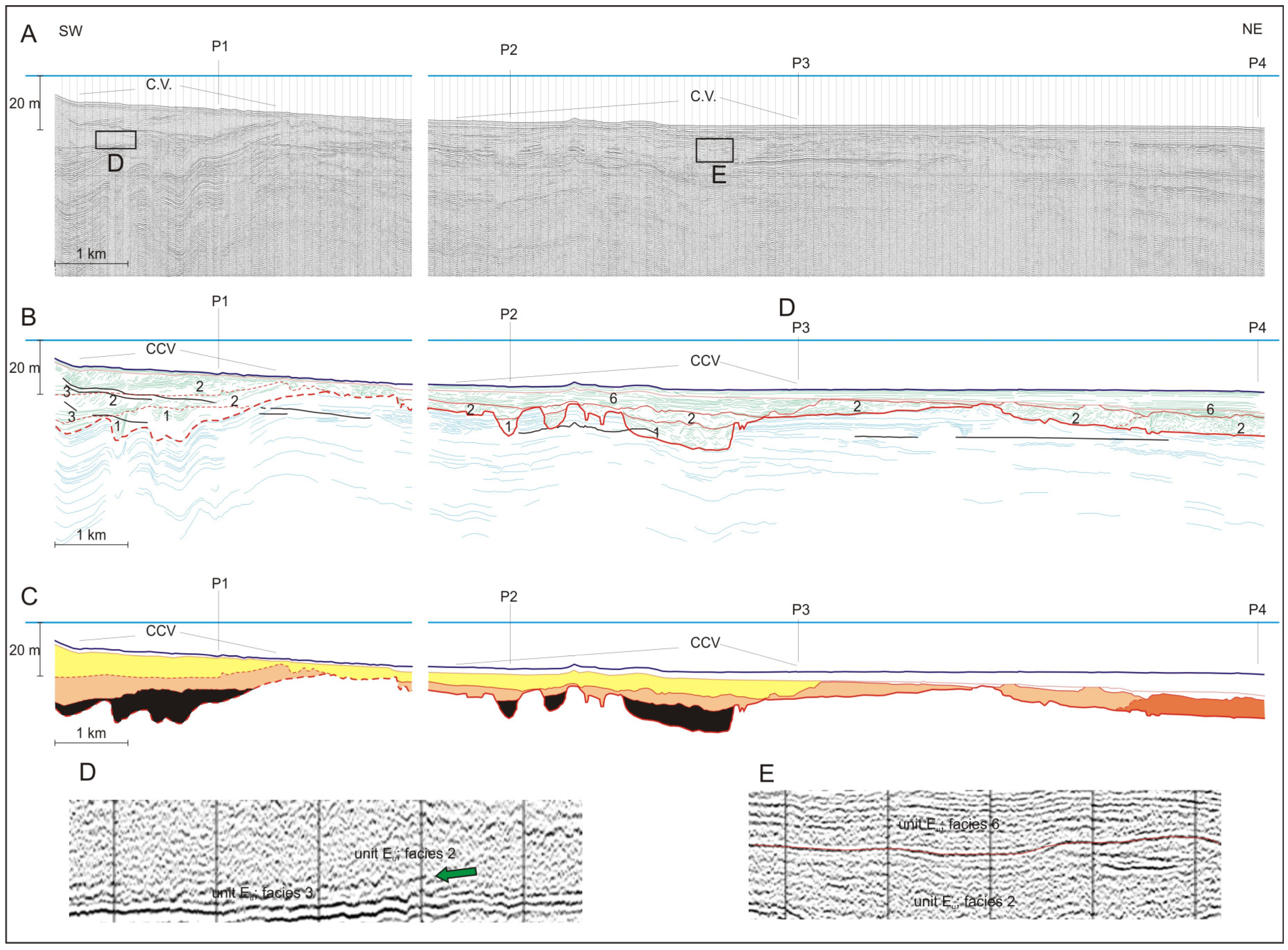

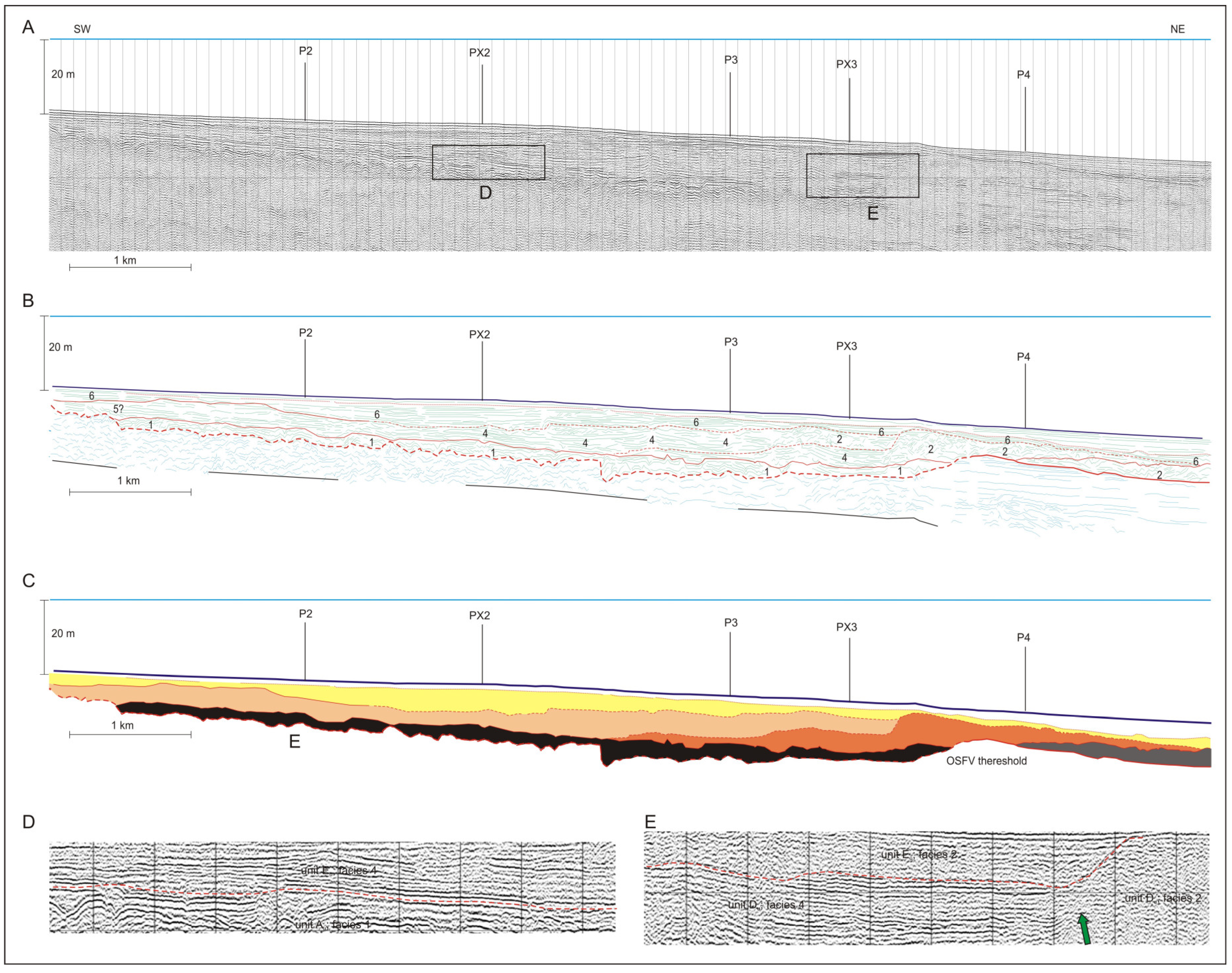
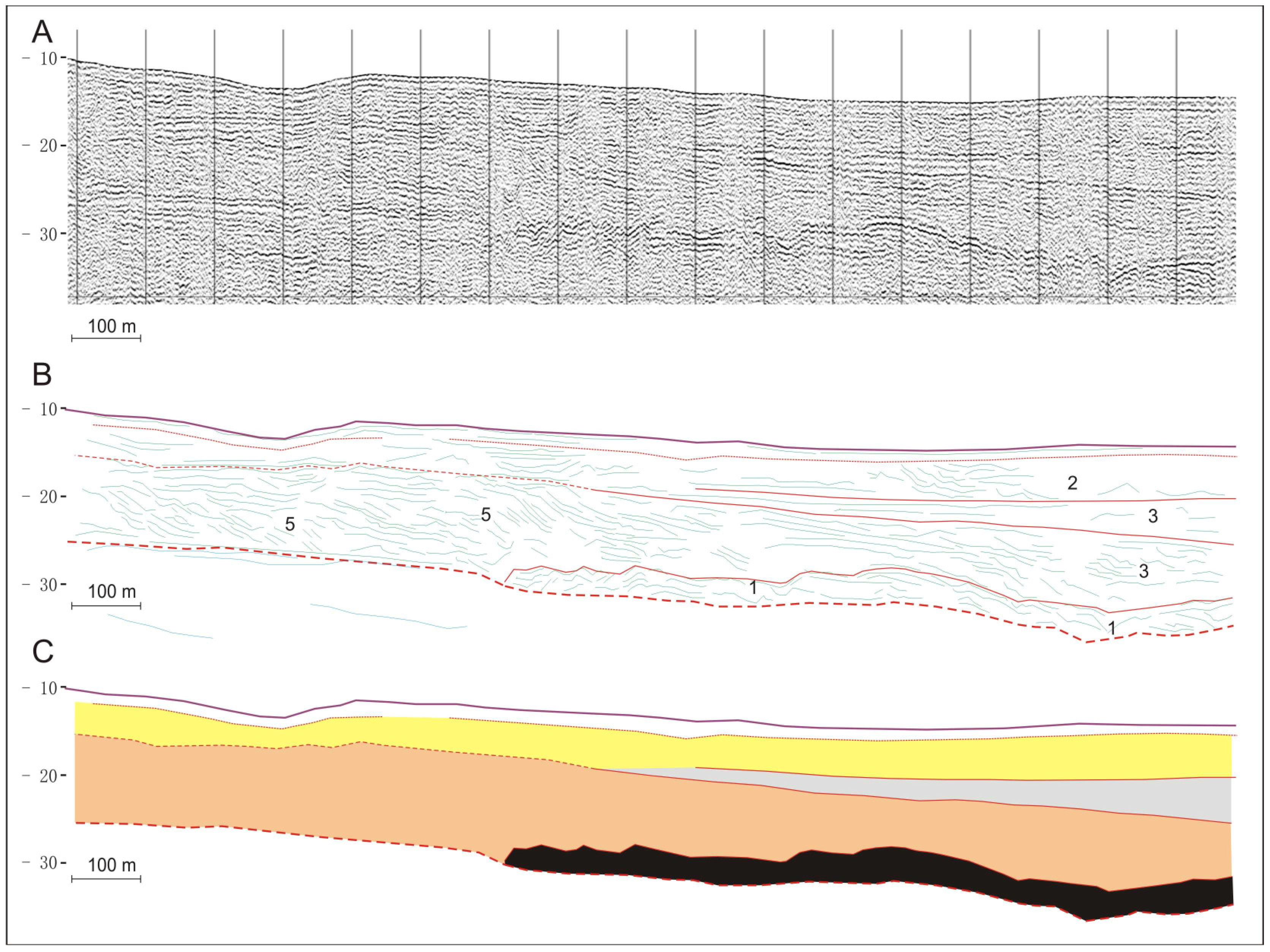


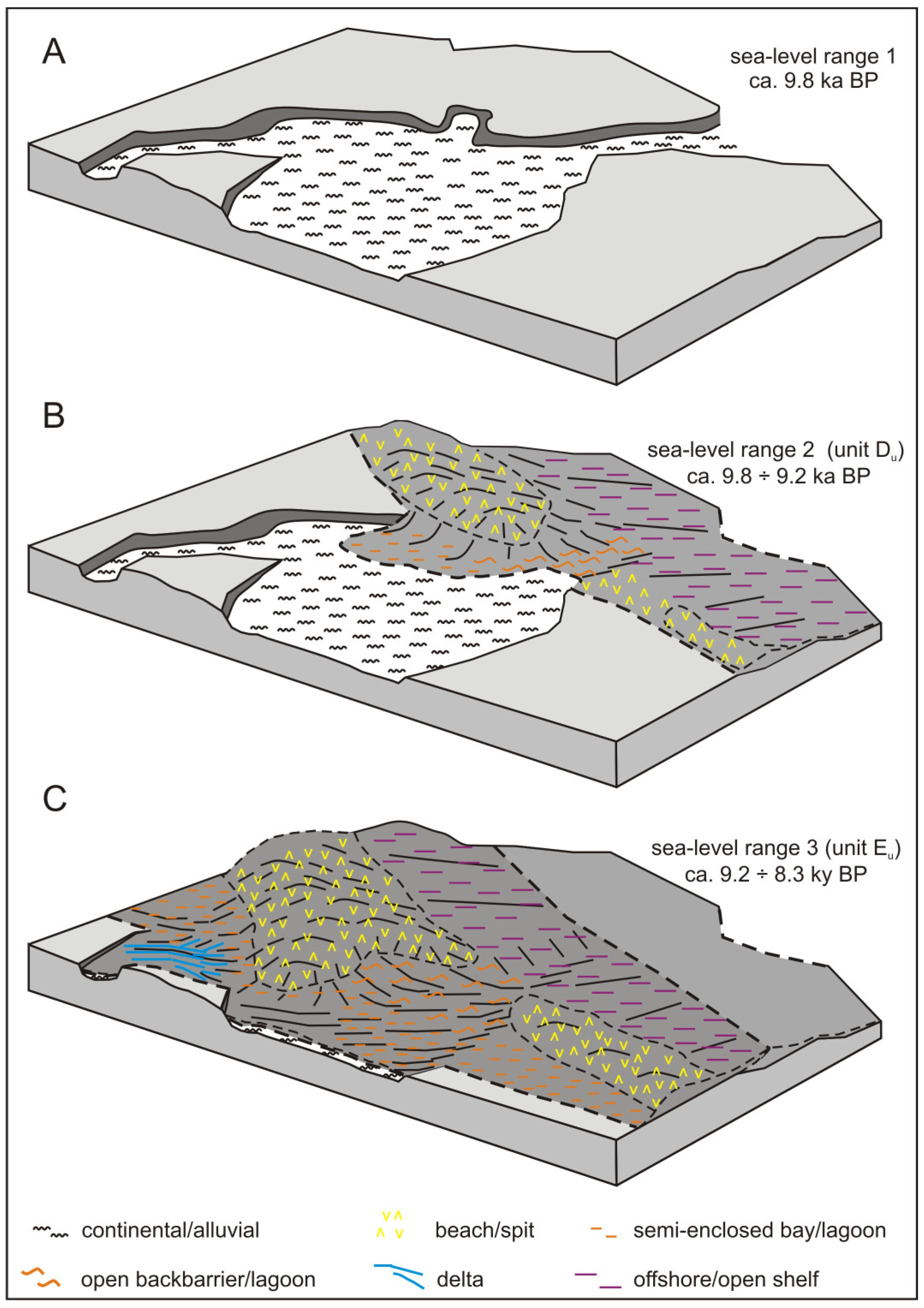
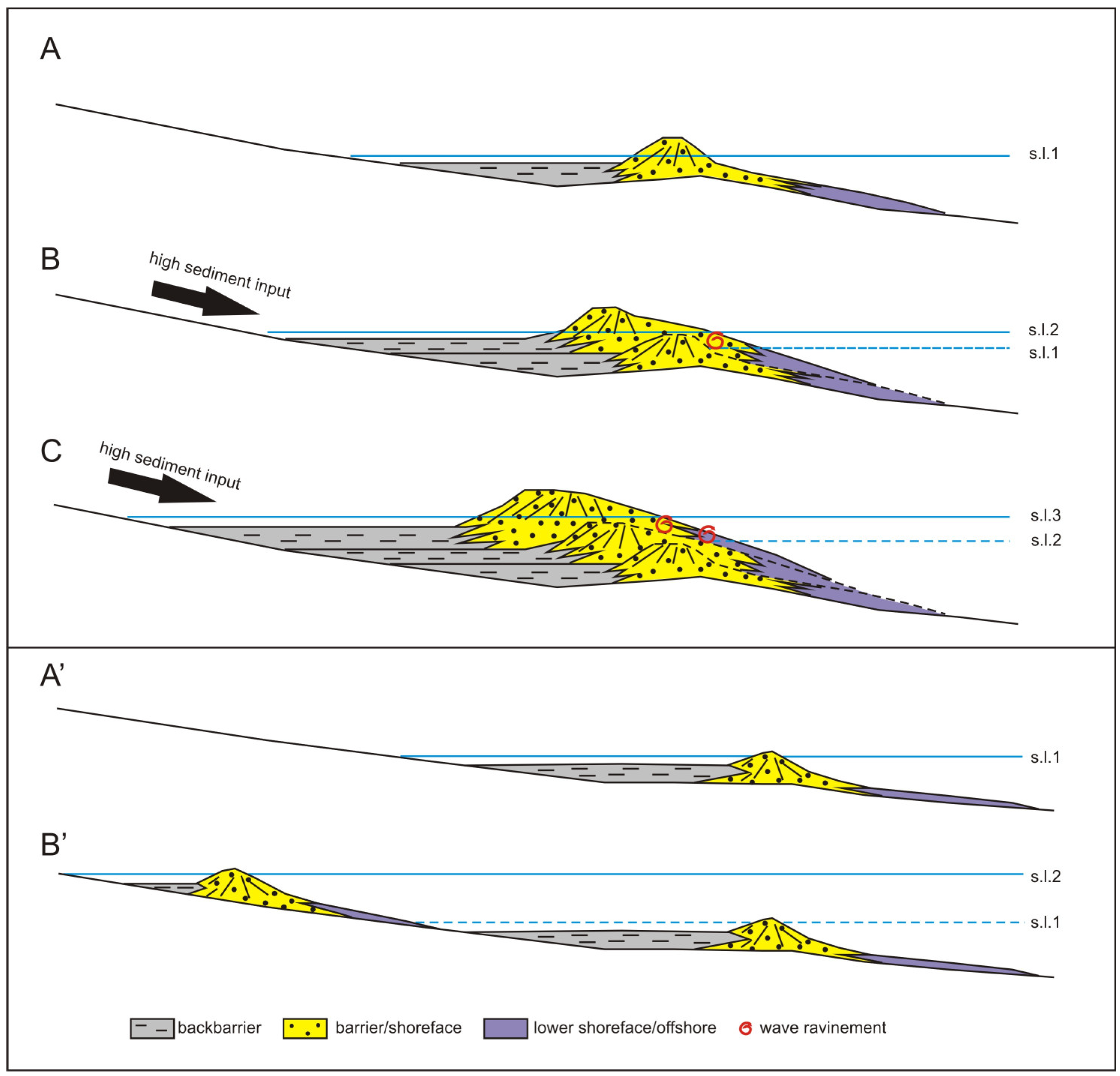
| Lab. ID. | Submitter ID | Material | Calibration | δ(13C) ‰ | Radiocarbon Age (year BP) | Calibrated Age (year BP) |
|---|---|---|---|---|---|---|
| D-AMS 007669 | ZS2/4.80 | Donax semistriatus | marine13 | 5.8 | 2090 ± 23 | 1527 ± 161 |
| D-AMS 007670 | ZS2/7.60–7.70 | wood/organic | intcal13 | −25.1 | 3668 ± 25 | 4002 ± 82 |
| D-AMS 007672 | ZS2/28.65 | wood/organic | marine/intcal13 | −14.3 | 8401 ± 37 | 9160 ± 137 |
© 2020 by the authors. Licensee MDPI, Basel, Switzerland. This article is an open access article distributed under the terms and conditions of the Creative Commons Attribution (CC BY) license (http://creativecommons.org/licenses/by/4.0/).
Share and Cite
De Santis, V.; Caldara, M.; Pennetta, L. “Continuous” Backstepping of Holocene Coastal Barrier Systems into Incised Valleys: Insights from the Ofanto and Carapelle-Cervaro Valleys. Water 2020, 12, 1799. https://doi.org/10.3390/w12061799
De Santis V, Caldara M, Pennetta L. “Continuous” Backstepping of Holocene Coastal Barrier Systems into Incised Valleys: Insights from the Ofanto and Carapelle-Cervaro Valleys. Water. 2020; 12(6):1799. https://doi.org/10.3390/w12061799
Chicago/Turabian StyleDe Santis, Vincenzo, Massimo Caldara, and Luigi Pennetta. 2020. "“Continuous” Backstepping of Holocene Coastal Barrier Systems into Incised Valleys: Insights from the Ofanto and Carapelle-Cervaro Valleys" Water 12, no. 6: 1799. https://doi.org/10.3390/w12061799
APA StyleDe Santis, V., Caldara, M., & Pennetta, L. (2020). “Continuous” Backstepping of Holocene Coastal Barrier Systems into Incised Valleys: Insights from the Ofanto and Carapelle-Cervaro Valleys. Water, 12(6), 1799. https://doi.org/10.3390/w12061799





